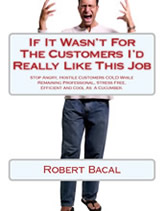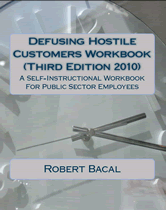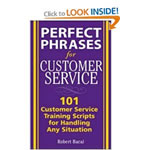
Understanding Hostile Customers
If you enjoy this article and wish to learn more about cooperative communication be sure to check out our quick read book called "Conflict Prevention In the Workplace - Using Cooperative Communication" by clicking here
Or, check out our Defusing Hostile Customers Workbooks HERE
You probably see hostile customers every day. You know, the ones that treat you like a personal dumping ground for everything that has ever gone wrong in their lives? They may be sarcastic, or abusive. They may swear at you, threaten, attempt to intimidate. They are difficult to deal with, and an encounter with one of these people can ruin your day.
Although you may be provoked, it isn't a good idea to respond in kind. Doing so will usually inflame the situation, and can in fact put you at risk. Yelling back, or trading insults can result in only negative consequences for you.
Let's face it. You don't have time to waste arguing and yelling...you have too much to do. But you do need to deal with hostile customers. You need to get the situation under control, deal with it and get on with your work.
There
are a number of techniques you can use to do this, but this month
we are going to help you understand what is going on when hostile
customers direct their anger at you. Understanding angry
people helps us become less reactive, and less prone to losing
our own temper.
It Ain't Personal
The
first thing to remember about angry customers is that while their
behaviour is directed at you (and it can be personally insulting),
the real source of the anger is elsewhere. The angry person
is not usually angry at you as a person. He or she is
usually angry at you as an employee of an organization that is
perceived as cold, unfeeling, and unhelpful. Since it is
difficult to yell or abuse an entire organization, the angry customer
will direct anger towards you.
What Does The Angry Person Want?
One
of the half-truths about hostile customers is that they want their
problem solved. This isn't the whole story. When a person
is initially denied something from an organization, they get to
a point where the problem becomes secondary. Yes, they want
the problem solved, but after a point, they get so angry that
they
are unwilling to work positively to get what they started out
wanting. Even if you could work something out with them,
they would still be angry.
It
is important to realize that very angry people want an opportunity
to vent their anger, and they want to be heard and acknowledged.
If you don't acknowledge their anger, and move too quickly to
try to solve the problem, you will likely make them angrier and
more abusive.
What To Do?
There are specific things you can do to take control of potential hostile situations so that they don't escalate into major time-consuming conflicts.
First, you need to observe customers as they approach, and prepare yourself for the possibility that they may show hostile behaviours.
People who are irritated or upset will show tell-tale signs even before they open their mouths. They will send non-verbal clues which may include hunched shoulders, clenched fists, red face, fidgeting and restlessness, staring or avoidance of eye contact, rapid movement, etc.
You need to look for these signs so that any outbursts do not surprise you. Many hostile situations get out of hand because the employee reacts too quickly to hostile behaviour, because he or she did not expect it.
If
you see a hostile person approach, prepare yourself mentally by
reminding yourself that you CAN control the situation, and that
you need to keep yourself under control. If you get angry
yourself you are likely to contribute to the deterioration of
the situation.
Second,
when you are in contact with a hostile customer, you must strive
to present yourself in as un-bureaucratic a way as possible.
Remember we talked about customer anger being really aimed at
the organization? If the customer perceives you as an object,
a piece of the bureaucracy, they will be more likely to
be more abusive. However, if the customer sees you as a
human being who doing the best you can, it is more likely that
he or she will show less aggressive behaviour.
Specifics:
Let's get more specific. How do you do this?
1) Speak in a friendly manner. Do not speak in a monotone or in a way that implies that you are uninterested.
2) When possible use the customer's name as soon as possible, and also introduce yourself if that fits the situation.
3) Greet the person properly. Don't look up from your paper work and say "Yes?", or "Next". That makes you look like part of a machine. Try "Good morning, Mr. Smith".
4) Listen carefully. Show the customer you are listening by paraphrasing what was said back to the customer. This shows your interest and concern. A common error made by people is that they don't allow the customer to finish.
5) Don't use the "P" word. The P word is "POLICY". Many times an employee will explain that it is against "our policy to do" what the client wants. This infuriates many people. Even if the request is against your policy, find other words to say it. Rather than simply quoting policy, explain the purpose of the policy (eg. "Sir, we need to make sure that you are dealt with fairly and others are too.")
6)
Never say "I only work here" or "I'm only following rules".
Again this makes you into a non-person. It may be true that
you don't make the rules, but try saying it this way: "Sir,
the regulations are made by [whoever]. Perhaps you might
want to talk to [so and so] and indicate that you feel the regulations
are unfair. Would you like the phone number?"
Conclusion:
Every hostile situation is different, and not all solutions will work all the time. The general principles we have talked about here are to be prepared by observing customers early in the process, and make sure that you come across as a real person.
There is a lot more to defusing hostile situations, and we will try to discuss some of the things you can do to gain control, and reduce the nasty outcomes of these kinds of conflict situations.





